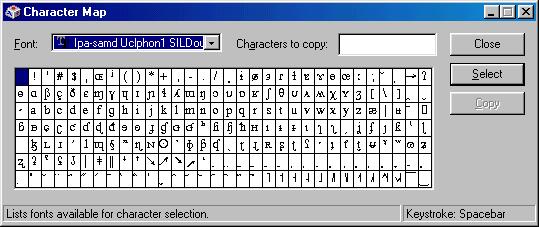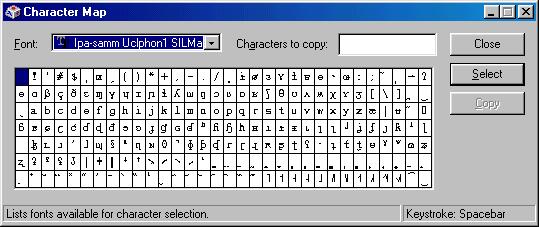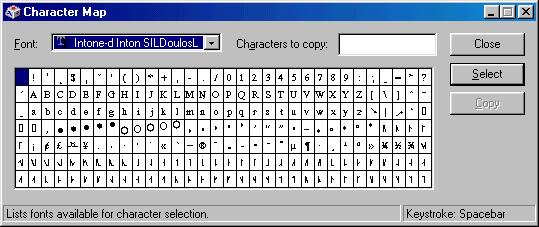DEPARTMENT OF SPEECH, HEARING & PHONETIC SCIENCES UCL Division of Psychology & Language Sciences |
 |
The IPA-SAM phonetic fonts
Now freely downloadable!
The IPA-SAM phonetic fonts are TrueType® fonts for use on IBM-compatible PCs running Windows. (They also work on Mac OSX.) With them installed, you can display phonetic symbols on the screen and print them out in any size. The IPA-SAM character set includes all the symbols of the International Phonetic Alphabet as currently recognized by the IPA. There are three typefaces: Doulos (similar to Times), Sophia (san serif) and Manuscript (similar to Courier, monospaced). All are available in regular, bold, italic, and bold italic.
The most useful phonetic symbols are mapped onto the keys of the ordinary keyboard. For example, if you type shift-D you get ð, while shift-C gives you ç; instead of the figure 2 you get ø and instead of the @ symbol you get a schwa. In this way you can immediately access all the symbols you need for the phonemic or broad-phonetic transcription of English, French, German, Spanish and many other languages. All the cardinal vowel symbols, primary and secondary, are here, together with a range of allophonic or general-phonetic symbols and stress marks (glottal stop, tapped r, dark l, r-coloured schwa, voiceless alveolar lateral fricative, palatalization diacritic, syllabicity mark, hacek, right arrow...). These key assignments are based on the SAM-PA recommendations.
The remaining IPA symbols -- numbering more than a hundred -- have been assigned to ANSI numbers in a logical order. They can be accessed by using the computer's numeric keypad while holding down the Alt key. All diacritics are 'floating', i.e. can be attached to any letter. There are also a number of phonetic symbols here that are seen in use from time to time although not (or no longer) recognized by the IPA.
To download, click on link.
You can either download the uncompressed individual fonts separately, or choose a compressed (zipped) file containing all of them, or a self-extracting file of them all.

| Doulos:
|
Sophia:
|
 |
 |
Manuscript:
|
| Also, as a special bonus, a font designed for work on tone and intonation, using iconic notation (e.g. O'Connor and Arnold or similar). Includes assorted dots (filled and empty, large and small, at various heights). |  |
Zipped file containing all the above fonts; or a self-extracting file containing them all.
Users of Microsoft Word for Windows (WinWord) can conveniently display the whole character set (once installed) by clicking on Insert Symbol and bringing the name of one of the IPA-SAM fonts (e.g. Ipa-samd) into the Font box. As an alternative to accessing the symbol via the keyboard or Alt+numeric, you can choose a symbol in this display and click on Insert. You can also, if you wish, customize shortcut keys for frequently used characters. You should disable some of the WinWord AutoCorrect functions - particularly those which automatically "correct" i to I or disallow TWo INitial CApitals.
Users of any word processor running under Windows can use the Windows Character Map to locate the characters they want.
Users of WordPerfect for Windows already have a phonetic character set available in WPWin, but one with a number of disadvantages (may display or print in unexpected sizes; phonetic characters are in a san serif font only; but the velar nasal, for example, is regarded as an "international" rather than as a phonetic symbol, and is available only in a serifed font). They will find the IPA-SAM fonts much more flexible. When printing from them, make sure to choose the Windows printer driver (not the WordPerfect printer driver). It will be necessary to disable some of the WPWin Quickcorrect functions: from Tools, chose QuickCorrect, then Options, then in Sentence Corrections turn off Capitalise First Letter, and in Double SmartQuotes turn off Double Quotes.
Users of WordPerfect 8 may encounter a problem printing certain characters -- particularly diacritics -- in the IPA fonts. To surmount this, set the code page within Wordperfect 8 as follows:-
- From the Format menu select fonts.
- From the resulting Font window select font map.
- From the Edit Printer/Document Font Mapping window select Code Pages
- In the Face box select each of the IPA fonts in turn and set the Code page to 1252 Windows US Standard. (They will probably be set to Default initially).
Users of most word processing applications can conveniently create a macro to switch into the IPA-SAM font, rather than changing the font by hand. To return to the default font, hit Ctrl-space (MS Word) or Ctrl-N (AmiPro, WordPro); for WPWin you will need another special macro.
The IPA-SAM fonts are proprietary copyrighted Encore fonts created using Typecaster software supplied by the Summer Institute of Linguistics. However, they can now be downloaded free of charge (see above). If you prefer to have them supplied on diskette, you may purchase a diskette from the Department of Phonetics and Linguistics, University College London.
A diskette with all three fonts, each in four combinations of style and weight, is available. For further details and how to order, please visit the Department's on-line shop: THE SHOP .
Page maintained by J.C.Wells. Last revised 2004 December 22
